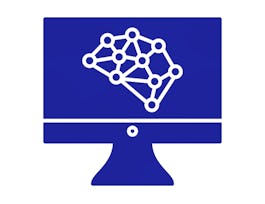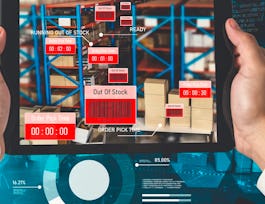This course will teach you how to leverage the power of Python to understand complicated supply chain datasets. Even if you are not familiar with supply chain fundamentals, the rich data sets that we will use as a canvas will help orient you with several Pythonic tools and best practices for exploratory data analysis (EDA). As such, though all datasets are geared towards supply chain minded professionals, the lessons are easily generalizable to other use cases.



Fundamentals of Machine Learning for Supply Chain
This course is part of Machine Learning for Supply Chains Specialization


Instructors: Rajvir Dua
Sponsored by Coursera Learning Team
3,736 already enrolled
(35 reviews)
Recommended experience
What you'll learn
Learn to merge, clean, and manipulate data using Python libraries such as Numpy and Pandas
Gain familiarity with the basic and advaned Python functonalities such as importing and using modules, list compreohensions, and lambda functions.
Solve a supply chain cost optimization problem using Linear Programming with Pulp
Skills you'll gain
- Supply Chain Management
- Jupyter
- Data Mapping
- Data Wrangling
- Pandas (Python Package)
- Operations Research
- Python Programming
- Data Engineering
- Data Processing
- Supply Chain
- NumPy
- Extract, Transform, Load
- Data Science
- Transportation, Supply Chain, and Logistics
- Operations Management
- Data Transformation
- Data Manipulation
- Business Operations
- Computer Programming
- Data Analysis
Details to know

Add to your LinkedIn profile
8 assignments
See how employees at top companies are mastering in-demand skills

Build your subject-matter expertise
- Learn new concepts from industry experts
- Gain a foundational understanding of a subject or tool
- Develop job-relevant skills with hands-on projects
- Earn a shareable career certificate


Earn a career certificate
Add this credential to your LinkedIn profile, resume, or CV
Share it on social media and in your performance review

There are 4 modules in this course
Welcome to the course! In this first module, we’ll learn about the fundamentals of programming and Python. We’ll start with basic data structures, functions, and loops and then some time becoming familiar with importing modules and libraries. Finally, we'll put our new skills to the test by optimizing a supply constraint problem using linear programming techniques.
What's included
12 videos5 readings3 assignments4 programming assignments1 discussion prompt5 ungraded labs
In this next module, we'll dive into the most common tools used for data science: Python, and Numpy. We'll start with Numpy, getting used to np arrays and their main functionality. After getting familiar with loading in data of all types, we'll learn about some basic data description and cleaning techniques. We'll also learn to work with indexes and columns in Dataframes. We'll end with an introduction to plotting and summary statistics. We will use common supply chain data sets for our explorations
What's included
9 videos3 readings3 assignments1 programming assignment1 discussion prompt2 ungraded labs
In this third module, we'll take our Pandas and Numpy skills to the next level, learning how to effectively combine and reshape data. We'll learn how to reshape data to fit with our needs through merges and pivots. This setup will help us tackle common data preprocessing steps necessary to run machine learning algorithms, such as one-hot encoding. Finally, we'll encounter the most important tools in our Pandas arsenal (Groupby-Apply-Transform) and explore its transformative functionality.
What's included
5 videos3 readings1 assignment1 programming assignment1 discussion prompt2 ungraded labs
In this final project, we'll take collection of various data sets involving warehouse capacities, product demand, and freight rates to optimize cost of producing and shipping products.
What's included
2 videos1 assignment1 programming assignment1 ungraded lab
Offered by
Why people choose Coursera for their career




Learner reviews
35 reviews
- 5 stars
42.85%
- 4 stars
28.57%
- 3 stars
11.42%
- 2 stars
8.57%
- 1 star
8.57%
Showing 3 of 35
Reviewed on Jan 24, 2024
love the progression from "key" basics and hands on problems
Reviewed on Nov 10, 2024
Good. Improvement in UI interface and lab should be improved
Recommended if you're interested in Data Science

LearnQuest

Coursera Project Network

Fractal Analytics

Open new doors with Coursera Plus
Unlimited access to 10,000+ world-class courses, hands-on projects, and job-ready certificate programs - all included in your subscription
Advance your career with an online degree
Earn a degree from world-class universities - 100% online
Join over 3,400 global companies that choose Coursera for Business
Upskill your employees to excel in the digital economy



